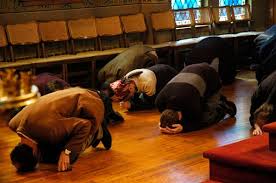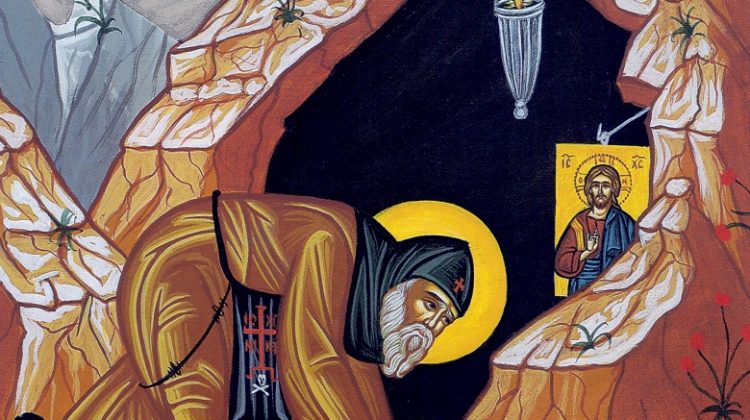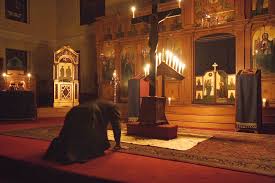Today’s blog post was originally published in March of 2019, but it seems appropriate to revisit the topic of prostrations during Great Lent. — LH
The Orthodox culture shock had been manageable so far. About 13 years ago my husband and I finally put down our introductory books on Eastern Christianity and approached the living, parish reality of Orthodoxy during something called the Triodion period before Great Lent.
Because we had prepared ourselves, the kissing of icons didn’t shock us. The chanted hymns weren’t exactly hummable, but a few random melodies stuck in my mind (“Through the prayers of the Theotokos, Savior, save us”), and the richness of the lyrics more than made up for the lack of a discernible rhythm. We were getting the hang of this Orthodox thing.

We approached Great Lent with great anticipation—finally, some real direction in preparing for Easter!—and then, right in the middle of a service, people started dropping to the floor. Together. Synchronized (sort of).
Well, this was new. In various Protestant gatherings, we had witnessed people raise their hands in prayer, sing in tongues, and even dance. We knew that Roman Catholics and the more liturgical denominations practice kneeling and genuflecting.
But I had never seen people fall to their knees, foreheads to the floor. Aren’t prostrations a Muslim thing? Or a Buddhist thing?
A Biblical Posture of Prayer
Prostrations are definitely Eastern. The Muslim practice of prostrations is a continuation from Islam’s earlier Christian history, and Christians inherited the practice from their Jewish roots, centuries before the Nativity of Christ.
In the Old Testament, when the people “fell on their faces” in the time of Moses and Aaron, they were doing prostrations. And the Book of Revelation records angels and elders falling on their faces before God.
For the average Orthodox layperson today, prostrations are most closely associated with the Prayer of St. Ephraim the Syrian. We recite this throughout Great Lent, prostrating ourselves after each clause:

Translations of this prayer vary from one jurisdiction to another. My parish has used the words, “Deliver me from the spirit of laziness and meddling, the lust for power, and gossip.” A friend from an OCA parish was accustomed to the wording above—“sloth, despair, lust of power and idle talk.” At a pan-Orthodox retreat, she whispered to me, “I can’t wait to get back to my church so I can start meddling again!”
Theology in Motion
When I first encountered prostrations in a service, I saw them as a rather dramatic, public way to humble ourselves before God. But our bishop helped me to understand that prostrations illustrate our spiritual journey: we fall down in life, and by God’s grace, we pick ourselves up and try again. And again.
Of course. Nothing in Orthodox worship is random or merely innovation for its own sake; every ancient practice means something and usually contains multiple layers of meaning. Writing in the 14th century, St. Theoliptos of Philadelphia emphasized the importance of prostrations in our prayer lives:
Do not neglect prostration. It provides an image of man’s fall into sin and expresses the confession of our sinfulness. Getting up, on the other hand, signifies repentance and the promise to lead a life of virtue. Let each prostration be accompanied by a noetic invocation of Christ, so that by falling before the Lord in soul and body you may gain the grace of the God of souls and bodies.
— “On Inner Work in Christ,” The Philokalia, vol. IV (London: Faber & Faber, 1995, p. 185)

Prostrations are a physical manifestation of an inner spiritual posture. In his article, “And Why Do We Make Prostrations?” Father John Beck writes,
In bending our knees we assume an attitude of humility before the God to whom we offer our prayer. Kneeling, then touching our forehead to the ground, we acknowledge our sinfulness; we create a living image of our fall into sin. Our very posture represents a confession of that state, a calling to mind of our spiritual poverty, of our susceptibility to passions of greed, lust, anger and malice. . . . Then, as we rise to our feet, this confession both of Christ and of our sinfulness becomes a bodily symbol, a virtual promise, that change will occur in our life. We commit ourselves to repentance, to a turning from the old Adam to the new.
A Brief How-to Guide
If you’ve never tried them, don’t be confused by the English definition of the word prostrate: “to lie flat.” In Eastern Christian practice, we don’t actually flatten ourselves completely.
Instead, we drop to our knees and touch our foreheads to the floor. Author and Khouria Frederica Mathewes-Green offers a simple how-to explanation in her article, “About Prostrations”:
Begin by making the sign of the Cross. Begin bending forward, and begin to lower the palms of your hands to rest on the floor. It’s more efficient to focus on what you do with your hands than what you do with your knees, because if you focus on knees, it tends to become an awkward 2-stage camel-like process. But if you instead follow the sign of the Cross with a gentle controlled-fall forward, aiming to rest your palms to the floor, and allowing your knees to fall into place—then you can push off lightly from your palms and return to a standing position.
If this sounds too difficult, be encouraged that the Church offers grace regarding prayer postures. There is no legalistic requirement to perform prostrations. Newcomers might feel uncomfortable with the idea—or realize that they should have worn looser pants or longer skirts. Some people are unable to drop to their knees; others might be able to get to the floor but have great difficulty fighting gravity to get back up again.
Such people can instead perform a metania (pronounced meh-TAHN-yeh), making the sign of the cross then bowing forward and reaching to the floor (or as close to it as possible) with the right hand. Fittingly, the word metania comes from the Greek metanoia, which means “change of heart” or “repentance.”
Folks in wheelchairs can bow their heads in reverence while others prostrate. Even without a full prostration, we can all declare with our bodies our desire to change our fallen ways and return to God.
When Are We Supposed to Do This?
For laypeople, Great Lent is the major season of prostrations. In addition to the three of them in the Prayer of St. Ephraim, during the first week of Lent the penitential Canon of St. Andrew of Crete includes many, many prostrations.
I tried to count them once. Suffice it to say that there were so many, I lost track. As I worked up a bit of a sweat, I began to understand why some Orthodox wags refer to prostrations as “Orthorobics.”

There are specific times not to make prostrations, such as on certain feast days. Also, during the Divine Liturgy, Orthodox tradition instructs the faithful to refrain from kneeling in prayer between Pascha and Pentecost. We also don’t do prostrations on Sundays, because it is a day of celebrating the Resurrection.
That’s a lot to remember. When in doubt, just look for one of those knowledgeable older women in your parish, and follow her lead.
In private practice, some people prostrate themselves when venerating icons, visiting a holy site, or saying the Jesus Prayer. Many faithful incorporate prostrations into their daily prayer rule. It is always a good idea to seek your spiritual father’s counsel on such things.
A Physical Expression of a Gift of Grace
This posture of prayer expresses inner change, but we do not gain holiness as a result of prostrations or even by deciding to repent. Our Lenten practices of prayer, fasting, and almsgiving—as well as prostrations, Bible reading, or any other personal sacrifice—“are never ends in themselves,” Fr. John writes. He continues,
As the Holy Fathers teach repeatedly, they exist for the sole purpose of leading us to Christ, who alone heals our brokenness, forgives our sin, and draws us into eternal communion with God and with one another. . . . Like every aspect of our Christian life, this transformation—the power to act upon our commitment—is a gift of grace that comes down “from above, from the Father of lights.” (James 1:17)
When you try prostrations in your parish, don’t worry about your own clumsiness. The people around you are busy trying to keep their balance and haul themselves up from the floor.
They aren’t focused on you. I promise.
The Orthodox Christian Faith involves the body and all the senses in worship. It is far more than a head trip, an intellectual assent to propositional truths. The physicality of the Faith shapes us, giving us continual reminders of our need for mercy and of God’s grace. So, as we are able, let’s offer prostrations during Great Lent, allowing our bodies, minds, and spirits to agree together that although we fall down in life, by God’s grace, we pick ourselves up and try again. And again.